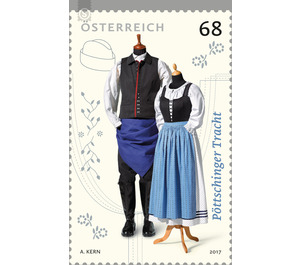strive - Austria / II. Republic of Austria 2017 - 68 Euro Cent
Theme: Devices, Items & Instruments
| Country | Austria / II. Republic of Austria |
| Issue Date | 2017 |
| Face Value | 68.00 |
| Edition Issued | 350,000 |
| Perforation | 13¾ x 14 |
| Printing Type | offset |
| Stamp Type | Commemorative |
| Item Type | Stamp |
| Chronological Issue Number | 2675 |
| Chronological Chapter | OOS-OE2 |
| SID | 405686 |
| Dimensions | 50.00 x 32.00 |
| In 81 Wishlists | |
The Pöttschinger costume goes back to the traditional folk costumes from the Burgenland and to the Pöttschinger musician Peter Zauner. Peter Zauner was among others a violinist with Carl Michael Ziehrer and also a composer, he wrote the melody to the Burgenland national anthem. After the First World War he founded the brass band Pöttsching. In 1928, a large music festival was held in his homeland, in which Zauner performed with his band for the first time in Burgenland costume and with great success traditional songs and folk dances were performed. In 1980 and 1981, there were the first folk dance performances at the Pöttschinger farmers' ball and at the farmers markets - initially in different Dirndln, the guys in black pants, white shirts and red scarves. The Pöttschinger costume was finally by Martina Löffler and Dr. med. Clara Prickler reproduced from the Heimatwerk based on old photos, 1984 sewn and embroidered by the dancers themselves and presented for the first time at the Music Festival on the occasion of "15 years Musikverein Pöttsching". The boy's costume was made in 1985 after the costume of Peter Zauner. The men's costume is typical Burgenland: black boots pants and boots, a white shirt, a vest with collar, red pink edge and silver buttons, the bottom four as double buttons. You wear the vest either open or the bottom six button rows closed. Particularly striking is the Firta: a kind of apron or "Vortuch" in blue, which wear the men, while a Zipf at the hip in the waistband is inserted - in single men on the right, in married men on the left. For this purpose a black hat or no headgear is worn in the summer, in winter an Astrachankappe - a cap of Karakulfell - and a black Janker. The women's clothing consists of a black, laced bodice and a white blouse. The girls wear a white skirt with scattered flowers and three blue ribbons at the hem, older women sometimes also a dark skirt with scattered flowers. This includes a blue striped apron and for cold days a short black traditional jacket or a shawl. A headgear is not common.


